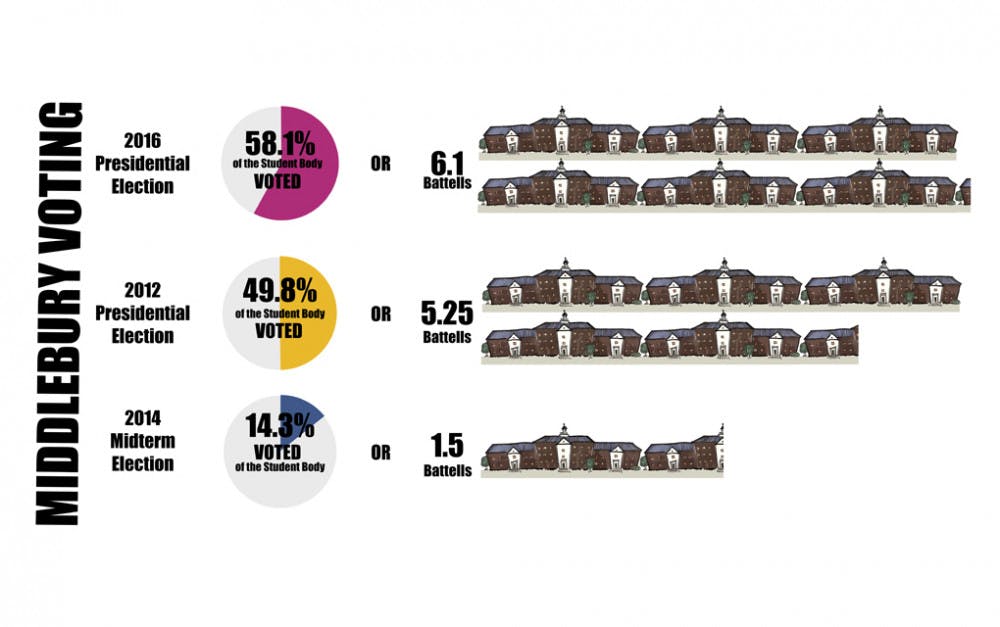ESME FAHNESTOCK
Historically, college students vote at lower rates than other demographics, and midterm elections tend to have particularly low voter turnout compared to presidential election years. Middlebury students’ voting record proves no exception.
58.1 percent of eligible Middlebury students voted in the 2016 presidential election, according to the National Study of Learning, Voting, and Engagement (NSLVE), a report conducted by Tufts University. This was an increase from the college’s 2012 presidential election turnout, when 49.8 percent of eligible students voted. Turnout in the 2014 midterm elections was far lower, with 14.3 percent of students voting.
College students may face structural limits when trying to exercise their right to vote. Ashley Laux ’06, program director for the Center for Community Engagement (CCE), said that there can be a lot of misunderstanding about the voting process.
“There is lot of general not-knowing,” Laux said. “How do I register to vote if I’m not there? When is the absentee ballot request deadline? Or sometimes they pull up the forms and feel like it might be kind of confusing.”
Laux also said that voting engagement for college students may have declined due to a decreased emphasis on civics education programs in high schools.
“Students aren’t learning about basics around government systems or how state and federal governments work, and if some of that foundational knowledge is missing, then students’ desire or tendency to vote may have gone down,” she said.
Other barriers are more logistical. According to Laux, not knowing where to buy a stamp has prevented voters from mailing in absentee ballots, and lacking transportation to the polls can inhibit voting. To combat these obstacles, the CCE is offering free stamps, which students can also find at Commons offices, the Center for Careers and Internships, the Mail Center and other locations around campus in the weeks leading up to the election. They will also be providing hourly rides from Adirondack Circle to the polls on Election Day, Tuesday, Nov. 6.
Ideological beliefs may also affect student voter engagement. Hazel Millard ’18, a former leader of the nonpartisan student initiative funded by the CCE called MiddVote, noted that the college’s turnout in 2016 was higher than the average voting rate of all the institutions that participate in NSLVE’s survey.
“Middlebury students were engaged in the 2016 election,” Millard wrote in an email to The Campus. “I think that was in part due to the primary competition between [Bernie] Sanders and [Hillary] Clinton, since Democrats on campus seemed fairly split between the two candidates. This meant that many were paying attention early on in the cycle.”
Ann Webster, the Middlebury Town Clerk, has noticed that college students’ political engagement depends on which issues dominate the news cycle.
“Over time, it seems like the news we get through the media is much more geared towards entertainment, rather than somebody just telling you the news and letting you form an opinion about it,” Webster said. “When I was younger, I think younger people did get engaged more than they did now because we had things like the Vietnam War, which was being shown to us every single day on the news and our friends were being drafted. It was something very political that had an impact on everybody’s daily life.”
Laux’s goal for the 2018 midterm elections is for 25 percent of eligible students to vote. Laux is also planning in the longer term, seeking to continue the upward voting engagement trajectory from the 2012 and 2016 presidential elections.
In their efforts to eliminate barriers to voting, Laux and the CCE have focused on a Tufts University report titled “Election Imperatives,” which was created as the result of research on ways to improve voter engagement on campuses.
The report offers recommendations for increasing student voter participation and improving “campus conditions for political learning, discourse and agency during the election season and beyond.” Two of the recommendations emphasize informing voters and creating a permanent coalition that focuses on more than voting during election season.
“One of the things I’m thinking about is, after this election, how can students, faculty and staff keep voter education going?” Laux said. “How can we view it as more of ongoing process of educating yourself about community issues? Because in the long term, that’s what will increase our voting rates the most: if people feel plugged into their community. Voting is just one slice of being connected as a citizen to your community.”
MiddVote’s student organizers are addressing the factors that lead to low turnout through person-to-person education and efforts to increase access to the polls.
Graphic by Esme Fahnestock.
Past College Students Didn't Go to the Polls

Comments



